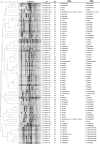Multilaboratory Survey To Evaluate Salmonella Prevalence in Diarrheic and Nondiarrheic Dogs and Cats in the United States between 2012 and 2014
- PMID: 28202802
- PMCID: PMC5405253
- DOI: 10.1128/JCM.02137-16
Multilaboratory Survey To Evaluate Salmonella Prevalence in Diarrheic and Nondiarrheic Dogs and Cats in the United States between 2012 and 2014
Abstract
Eleven laboratories collaborated to determine the periodic prevalence of Salmonella in a population of dogs and cats in the United States visiting veterinary clinics. Fecal samples (2,965) solicited from 11 geographically dispersed veterinary testing laboratories were collected in 36 states between January 2012 and April 2014 and tested using a harmonized method. The overall study prevalence of Salmonella in cats (3 of 542) was <1%. The prevalence in dogs (60 of 2,422) was 2.5%. Diarrhea was present in only 55% of positive dogs; however, 3.8% of the all diarrheic dogs were positive, compared with 1.8% of the nondiarrheic dogs. Salmonella-positive dogs were significantly more likely to have consumed raw food (P = 0.01), to have consumed probiotics (P = 0.002), or to have been given antibiotics (P = 0.01). Rural dogs were also more likely to be Salmonella positive than urban (P = 0.002) or suburban (P = 0.001) dogs. In the 67 isolates, 27 unique serovars were identified, with three dogs having two serovars present. Antimicrobial susceptibility testing of 66 isolates revealed that only four of the isolates were resistant to one or more antibiotics. Additional characterization of the 66 isolates was done using pulsed-field gel electrophoresis and whole-genome sequencing (WGS). Sequence data compared well to resistance phenotypic data and were submitted to the National Center for Biotechnology Information (NCBI). This study suggests an overall decline in prevalence of Salmonella-positive dogs and cats over the last decades and identifies consumption of raw food as a major risk factor for Salmonella infection. Of note is that almost half of the Salmonella-positive animals were clinically nondiarrheic.
Keywords: Salmonella; WGS; diarrhea; fecal organisms; pets.
Copyright © 2017 Reimschuessel et al.
Figures


Similar articles
-
Prevalence and characterization of Escherichia coli and Salmonella strains isolated from stray dog and coyote feces in a major leafy greens production region at the United States-Mexico border.PLoS One. 2014 Nov 20;9(11):e113433. doi: 10.1371/journal.pone.0113433. eCollection 2014. PLoS One. 2014. PMID: 25412333 Free PMC article.
-
Isolation, antimicrobial susceptibility patterns, and risk factors assessment of non-typhoidal Salmonella from apparently healthy and diarrheic dogs.BMC Vet Res. 2022 Jan 15;18(1):37. doi: 10.1186/s12917-021-03135-x. BMC Vet Res. 2022. PMID: 35033077 Free PMC article.
-
Evaluation of the association between feeding raw meat and Salmonella enterica infections at a Greyhound breeding facility.J Am Vet Med Assoc. 2006 May 15;228(10):1524-32. doi: 10.2460/javma.228.10.1524. J Am Vet Med Assoc. 2006. PMID: 16677120
-
Prevalence, Antimicrobial Resistance, and Molecular Characterization of Salmonella in Cattle, Beef, and Diarrheic Patients in Bishoftu, Ethiopia.Foodborne Pathog Dis. 2021 Apr;18(4):283-289. doi: 10.1089/fpd.2020.2869. Epub 2021 Feb 9. Foodborne Pathog Dis. 2021. PMID: 33567225
-
Antimicrobial Resistance in Nontyphoidal Salmonella Isolates from Human and Swine Sources in Brazil: A Systematic Review of the Past Three Decades.Microb Drug Resist. 2020 Oct;26(10):1260-1270. doi: 10.1089/mdr.2019.0475. Epub 2020 May 15. Microb Drug Resist. 2020. PMID: 32412862
Cited by
-
Antimicrobial Drug-Resistant Salmonella in Urban Cats: Is There an Actual Risk to Public Health?Antibiotics (Basel). 2021 Nov 16;10(11):1404. doi: 10.3390/antibiotics10111404. Antibiotics (Basel). 2021. PMID: 34827342 Free PMC article.
-
Distinct fermentation and antibiotic sensitivity profiles exist in salmonellae of canine and human origin.BMC Microbiol. 2018 Feb 26;18(1):15. doi: 10.1186/s12866-018-1153-4. BMC Microbiol. 2018. PMID: 29482521 Free PMC article.
-
Search of antimicrobial lactic acid bacteria from Salmonella-negative dogs.BMC Vet Res. 2022 Jan 3;18(1):12. doi: 10.1186/s12917-021-03070-x. BMC Vet Res. 2022. PMID: 35042502 Free PMC article.
-
Emergence of Salmonella enterica subsp. enterica serovar Chester in a rural area of Japan.J Vet Med Sci. 2020 May 15;82(5):580-584. doi: 10.1292/jvms.20-0033. Epub 2020 Mar 19. J Vet Med Sci. 2020. PMID: 32188802 Free PMC article.
-
Occurrence of potentially zoonotic and cephalosporin resistant enteric bacteria among shelter dogs in the Central and South-Central Appalachia.BMC Vet Res. 2021 Sep 25;17(1):313. doi: 10.1186/s12917-021-03025-2. BMC Vet Res. 2021. PMID: 34563197 Free PMC article.
References
-
- Cartwright EJ, Nguyen T, Melluso C, Ayers T, Lane C, Hodges A, Li X, Quammen J, Yendell SJ, Adams J, Mitchell J, Rickert R, Klos R, Williams IT, Barton Behravesh C, Wright J. 2016. A multistate investigation of antibiotic-resistant Salmonella enterica serotype I 4,[5],12:i:− infections as part of an international outbreak associated with frozen feeder rodents. Zoonoses Public Health 63:62–71. doi:10.1111/zph.12205. - DOI - PMC - PubMed
Publication types
MeSH terms
Substances
Grants and funding
LinkOut - more resources
Full Text Sources
Other Literature Sources
Medical
Miscellaneous

